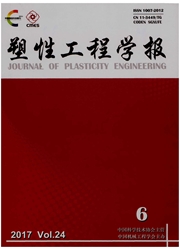

 中文摘要:
中文摘要:
通过微拉伸、电子背散射(EBSD)、透射电子显微镜(TEM)等手段,研究了具有亚稳奥氏体相的节约型双相不锈钢在1 000~1 200℃范围内不同固溶温度下的组织与性能的演变规律;探讨了固溶温度对形变诱导塑性(TRIP/TWIP)的作用机制。结果表明,随着固溶温度的升高,抗拉强度与伸长率均先升高后降低,而亚稳奥氏体相比例由74%(1 000℃)降低到37%(1 200℃);1 050℃固溶时,试验钢表现出最佳综合性能,抗拉强度达到960 MPa,伸长率达到62%,强塑积达到60 GPa·%。在经拉伸变形的微观结构中形变诱导马氏体与形变孪晶共存,表明试验钢中亚稳奥氏体相的变形机制主要受TRIP及TWIP共同控制,从而导致其塑性变形过程呈现多阶段应变硬化特征,而钢中铁素体相的变形机制主要变形为位错的滑移。
 英文摘要:
英文摘要:
The evolution of microstructure and properties of a lean duplex stainless steel with metastable austenite phase at different solution temperatures of 1 000-1 200 ℃ were investigated by tension,transmission electron microscopy(TEM)and electron back-scattered diffraction(EBSD).The mechanism of solution temperature on the plasticity induced by deformation was discussed.The results show that with the increase of solution temperature,the tensile strength and elongation increased firstly and then decreased.The ratio of metastable austenite phase decreased from 74%(1 000 ℃)to 37%(1 200 ℃).When the solid solution was 1 050℃,the tested steel showed the best comprehensive performance with tensile strength of 960 MPa,elongation of 62% and the strength and ductility product of nearly60 GPa·%.Deformation induced martensite and deformation twins were found in the metastable austenite after tensile deformation,which indicated that the deformation mechanism of the metastable austenite in the present steel was mainly affected by both TRIP and TWIP,which led to the multi-stage strain hardening characteristics.On the other hand,the deformation mechanism of the ferrite phase was dominated by the slip of the dislocation.
 同期刊论文项目
同期刊论文项目
 同项目期刊论文
同项目期刊论文
 期刊信息
期刊信息
